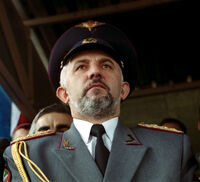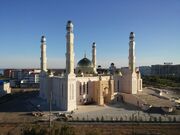|
Bostandıq, Patrïotïzm, Zañ (Kazakh) ("Freedom, Patriotism, Law") | |||||||
| Capital | Petropavl (formerly,) Kostanay (current) | ||||||
| Largest city | Kurgan | ||||||
| Language official |
Kazakh | ||||||
| others | Other Turkic languages, Russian | ||||||
| Religion main |
Sunni Islam | ||||||
| others | Orthodox Christianity, Buddhism | ||||||
| Ethnic Groups main |
Kazakhs | ||||||
| others | Russians, Tatars, Uzbeks, Uyghurs | ||||||
| Demonym | Kazakh | ||||||
| Government | Federal one-party Islamic state under a military dictatorship | ||||||
| Legislature | Parliament of the Russian Autonomous Zone (RAZ district) Armed Forces of the Governor-Generalship of the Steppe (everywhere else) | ||||||
| Governor-General | Aslan Maskhadov | ||||||
| Second in Command | Akhmad Kadyrov | ||||||
| Area | 478,189 km² | ||||||
| Population | 2,500,000~ | ||||||
| Independence | from the Soviet Union | ||||||
| declared | October 5th, 1988 (post-Doomsday) | ||||||
| Currency | Kazakhstani Tenge (₸) | ||||||
| Time Zone | UTC+05:00 (West Kazakhstan Time) | ||||||
The Republic of Kazakhstan (Kazakh: Қазақстан Республикасы), officially the Governor-Generalship of the Steppes, or sometimes called the Islamic State of Kazakhstan (Қазақстан Ислам мемлекеті) is a Kazakh survivor state in the provinces of Kostanay, select northern areas of Aktobe and Karagandy, eastern areas of Northern Kazakhstan, and several Uralic Russian cities. It is led by Aslan Maskhadov under the Islamic Awakening of Kazakhstan: a Jihadist, ultranationalist, and anti-communist political party posing as a military dictatorship. Akhmad Kadyrov serves as the Second in Command and aids in governmental affairs while Aslan Maskhadov is in command of the military. The nation borders Socialist Siberia to the east, the Khanate of Aralia to the south, and is situated along both the Ishim and Irgiz rivers. It is by far the largest survivor state located in Central Asia.
The national anthem is the former State Anthem of the Kazakh SSR. Due to the Governor-Generalship's anti-communist rhetoric, the preceding Soviet brass melody used for the State Anthem of the Soviet Union and state anthems for all other Soviet Socialist Republics has been omitted. Additionally, the anthem has been renamed to "Ежелгі Жер (Ejelgi Jer)" which translates to "Ancient Earth" in Kazakh.
History[]
Historical Background[]
Historically, the Governor-Generalship of the Steppes was a portion of the Russian Empire based in Central Asia. It was established in 1848 as a successor state to the Kazakh Khanate and disbanded in 1918 when the short-lived Alash government took control of the region. In 1897, Omsk was the capital, but later on, the capital was changed to Tashkent.
Pre-Doomsday[]
Prior to Doomsday, Aslan Maskhadov was serving under a Soviet self-propelled artillery regiment in Hungary. In 1981, he graduated with honors from the Leningrad Kalinin Higher Artillery. He served under the self-propelled artillery brigade until September 26th, 1983: also known as Doomsday.
Doomsday[]
During Doomsday, many Hungarian cities were bombarded by nuclear warheads. Using his Soviet nuclear drill training to his advantage, Aslan Maskhadov and his brigade of soldiers survived the nuclear holocaust. After livable conditions (in terms of the radiated atmosphere) resumed, Maskhadov used his newfound position to help launch an invasion into the remains of the Austrian government.
Post-Doomsday[]
After hostilities ceased, Aslan Maskhadov initiated multiple raids on survivor communities. Since then, his warlord-ship was memorialized by his victims.
After Doomsday, Aslan Maskhadov’s political positions radicalized and he soon was no longer loyal to communist forces. He and his militia had grown attached to an anti-Western sentiment, and the nuclear aftermath aided in converting Maskhadov's brigade to religious fundamentalism (particularly of Sunni Islam). Soon after, Maskhadov promised to his brigade that they would begin a “long-march” to their “ancestral homeland.”
Starting on October 7th, 1983, the long-march began. Firstly, the brigade crossed the Hungarian border into Ukraine and raided survivors along the way. An entire year was spent crossing the former Ukrainian Soviet Socialist Republic. Afterward, they made it to the Don-Kuban region of Russia. Thereafter, the Volga became a temporary settlement for them. In 1985, they approached the city of Aktobe.
As it was mostly deserted, Aktobe became the home-base for what would soon turn into the Governor-Generalship of the Steppes. The few native Kazakhs that survived Doomsday and were still in the general vicinity soon defected to Aslan Maskhadov’s cause. This only fueled their nationalist spirits.
Contrary to this, large Russian survivor communities situated in Northern Kazakhstan were reluctant to join his cause. To combat this, Aslan Maskhadov formed a military brigade that would help occupy Russian communities by force. The Russian populations of Kazakhstan would soon face prejudice under Aslan Maskhadov’s rule, and for this reason, Russian civil unrest was extremely high during Maskhadov’s era of conquest.
In 1988, a majority of former Kazakhstan was under Aslan Maskhadov's jurisdiction. Other survivors that were residing in Central Asia such as Akhmad Kadyrov became citizens of the young Governor-Generalship. Impressed with Maskhadov's leadership abilities, Akhmad Kadyrov aspired to become a part of the government. Luckily for him, Maskhadov thought that his power was slowly slipping and thus he needed a new minister to control the government. Akhmad Kadyrov was thereafter appointed as the Second in Command.
Government[]

Governor-General Aslan Maskhadov
The Governor-Generalship has a dictatorial regime with Aslan Maskhadov demonstrating a strong grip over both the Kazakh majority and Russian minorities. Additionally, only Sunni Islam has been recognized as an official state religion despite the sizable Orthodox Christian minorities in the north. The Governor-Generalship is usually described to be a military dictatorship, with some other outside sources even labeling it as an absolute monarchy or theocratic state. Additionally, Akhmad Kadyrov has implemented several "Ordonationalist" ("order nationalist") policies that have only strengthened the military's control.

Second in Command Akhmad Kadyrov
Federal Districts[]
As a federal state, the Governor-Generalship has federal districts that are controlled by members of the Islamic Awakening of Kazakhstan and the military. These were created as a way to make the one-party control more feasible. Since their establishment, these federal districts have become their own fiefdoms under military chiefs loyal to Aslan Maskhadov.
While all of these regions have state-appointed leaders of Kazakh ethnicity, Vitaly Pashin of the Russian Autonomous Zone (RAZ) forced the government to appoint him as the RAZ's leader. This was due to multiple protests and terrorist militias that had formed in direct response to the Kazakh rule. Vitaly Pashin is the only independent politician that has dominion over a province in the Governor-Generalship.
The Kustanay district (which encompasses the capital Kostanay) is under direct administration by Akhmad Kadyrov. Other district governors are permitted to establish local recruitment centers which indoctrinate members for the Islamic Awakening of Kazakhstan. The Kustanay district has the most densely-populated Kazakh majorities while the Russian Autonomous Zone encompasses all of the former Soviet Union that is administered by the Governor-Generalship.
Politics[]
Political opposition, while outlawed, has become increasingly difficult to combat for Aslan Maskhadov’s cabinet. At least 4 opposition parties currently exist. Seeing as they hold no real power or representation within the Governor-Generalship's cabinet, they are seen as rebel/terrorist groups.

The current political make-up of the Russian Autonomous Zone's parliament. Grey denotes to the Independents - Pashin's cabinet, blue denotes the Kazakh Fatherland Party, purple denotes the Kazakh Dawn Party, and green denotes the Islamic Awakening of Kazakhstan.
The current parties include:
- Islamic Awakening of Kazakhstan - The current ruling party.
- Kazakh Dawn Party
- Fatherland Party
- Communist Party of Kazakhstan
- Alliance of the Alash Orda - Their leaders have been detained.
A supreme government under the Islamic Awakening of Kazakhstan is omnipresent in every district excluding the Russian Autonomous Zone. Under Vitaly Pashin, a new district-level constitution was ratified and the Parliament of the Russian Autonomous Zone was created. The RAZ currently operates under a dominant Independent political alliance under Vitaly Pashin.

Results of the party affiliation census.
Ideologically, most of the Governor-Generalship is undoubtedly loyal to Aslan Maskhadov and his cabinet. This is due to his numerous revitalization efforts and patriotic speeches that have invigorated the populous over time. Nomadic citizens also generally approve of his leadership.
Local censuses were performed on citizens over 18 (the minimum age required to join the military, participate in politics, etcetera). This census was conducted under Aslan Maskhadov's approval (albeit, it was only agreed on so that it could theoretically catch and apprehend members of the Alliance of the Alash Orda). In it, citizens were prompted with what political party they personally affiliate themselves with. The effectiveness of this census has been disputed, seeing military personnel was excluded. The unusually high support for the Islamic Awakening of Kazakhstan in the general populous has been attributed to political coercion.
Political Parties[]
Islamic Awakening of Kazakhstan[]
Islamic Awakening of Kazakhstan Ïslamdıq Oyanw Qazaqstan | |
|---|---|
 | |
| Abbreviation | IAoK |
| Leader | Aslan Maskhadov |
| Founded | 1990 |
| Headquarters | Kostanay |
| Youth wing | Kazakh Patriotic and Religious Youth Organization (KPRYO) |
| Membership | 32,000 |
| Ideology | Islamic fundamentalism Pro-military junta Anti-communism Anti-Western sentiment Anti-Sovietism |
| Political position | Right-wing to far-right |
| Colors | Dark green, blue |
The Islamic Awakening of Kazakhstan (Kazakh: "Қазақстанның исламдық оянуы") is the current ruling party of the Governor-Generalship of the Steppes. Originally, it was the ruling military junta but was later formalized into a political party. Currently, it is the sole legal party.
The party has a fervent anti-Western outlook and a general opposition to communism. The party wants to contain Socialist Siberia's regional power.
Under Aslan Maskhadov's leadership, it is required that any military personnel must affiliate themselves with the Islamic Awakening of Kazakhstan.
The Kazakh Patriotic and Religious Youth Organization (or KPRYO for short) is mostly comprised of aspiring military personnel 16 and younger.
Kazakh Dawn Party[]
Kazakh Dawn Party | |
|---|---|
 | |
| Abbreviation | KDP |
| Leader | Dania Espaeva |
| Founded | 1988 |
| Headquarters | None |
| Youth wing | Kazakh Opposition and Justice Society (KOJS) |
| Membership | 8,800 |
| Ideology | Social democracy Eco-socialism Secularism |
| Political position | Centre-left to left-wing |
| Colors | Blue, pink, red |
The Kazakh Dawn Party was perhaps one of the first opposition movements to form in the Governor-Generalship of the Steppes. It is a social-democratic and secular party.
The youth wing, while small, is a training ground for resistance members against the Islamic Awakening of Kazakhstan.
The Kazakh Dawn party seeks to revive the Kazakhstani industry via green politics. Seeing as a majority of the Governor-Generalship's population resides in rural localities, the Kazakh Dawn Party has made considerable gains.
Fatherland Party[]
Fatherland Party Nur Otan | |
|---|---|
 | |
| Abbreviation | NOT |
| Leader | Askar Mamin |
| Founded | 1989 |
| Headquarters | None |
| Membership | 12,000 |
| Ideology | National conservatism Right-wing populism |
| Political position | Right-wing |
| Colors | Blue, white |
The Kazakh Fatherland Party is a party that seeks to end Aslan Maskhadov's military junta and the racism against the Russian minorities.
The party is increasingly popular among the native Kazakh youth as well as defectors of Aslan Maskhadov's Islamic Awakening of Kazakhstan.
Communist Party of Kazakhstan[]
Communist Party of Kazakhstan Qazaqstan Kommýnıstik Partııasy | |
|---|---|
 | |
| Abbreviation | QKP |
| Leader | Daniyal Akhmetov |
| Founded | 1989 |
| Headquarters | None |
| Membership | 6,650 |
| Ideology | Marxism-Leninism Communism |
| Political position | Far-left |
| Colors | Red, blue |
The Communist Party of Kazakhstan (Kazakh: Qazaqstan Kommýnıstik Partııasy) was the ruling party of the pre-Doomsday Kazakh Soviet Socialist Republic. It has since been revitalized and is now under the leadership of Daniyal Akhmetov.
Alliance of the Alash Orda[]
Alliance of the Alash Orda | |
|---|---|
 | |
| Abbreviation | AAO |
| Leader | Vacant "the Grand Khan" (customary name) |
| Founded | 1990 |
| Headquarters | None |
| Membership | Unknown Estimate: 3,500 or less |
| Ideology | Pan-Turkism Reactionism National-Bolshevism Anti-military junta Anti-Russian sentiment |
| Political position | Far-right (with far-left elements) |
| Colors | Red, yellow, blue, black |
The Alliance of the Alash Orda (or the AAO for short) is a far-right political group known renowned for its anti-Russian sentiment, reactionary politics, and even National-Bolshevik outlook.
Members of the AAO are subject to constant raids by Maskhadovite soldiers. Many former leaders of the AAO are also currently imprisoned.
The party was accused of attempting to assassinate Aslan Maskhadov, but no leads to this were found.
RAZ Gubernatorial Election of 1990[]
| ‹ N/A | ||||
| 1990 Russian Autonomous Zone Gubernatorial Election | ||||
|---|---|---|---|---|
| All 50 seats in parliament 26 seats needed for a majority | ||||
| 25th December 1990 | ||||
| Turnout | 33% | |||
| First party | Second party | Third party | ||

|

|

| ||
| Leader | Vitaly Pashin | Kassym-Jomart Tokayev | Toleutai Raqymbekov | |
| Party | Independents | Fatherland | Islamic Awakening | |
| Leader's seat | - | - | - | |
| Last election | - | - | - | |
| Seats before | - | - | - | |
| Seats won | 30 | 10 | 7 | |
| Seat change | ▲ 30 (new) | ▲ 10 (new) | ▲ 7 (new) | |
| Popular vote | 142,862 | 65,102 | 22,503 | |
| Percentage | 60% | 26.2% | 8% | |
| Fourth party | ||||

|
||||
| Leader | Dania Espaeva | |||
| Party | Dawn
| |||
| Leader's seat | - | |||
| Last election | - | |||
| Seats before | - | |||
| Seats won | 3 | |||
| Seat change | ▲ 3 (new) | |||
| Popular vote | 14,335 | |||
| Percentage | 5.8% | |||
| File:- | ||||
| Colours show the winning party in each region. | ||||
Governor before election
Vitaly Pashin Independents
Elected Governor
Vitaly Pashin Independents | ||||
The Russian Autonomous Zone Gubernatorial Election of 1990 was held on December 25th, 1990. It was the first election, either local or national, to ever be held within the Governor-Generalship. While the government under Aslan Maskhadov disapproved of this, he decided not to act as it would only further decrease his popularity among the Russian population.
After Vitaly Pashin was appointed governor of the RAZ by popular demand, he used the autonomy of the RAZ to his advantage and created the Parliament of the Russian Autonomous Zone. Parliamentary elections were held in 1989, where Vitaly Pashin's non-partisan coalition won 30/50 seats.
A Gubernatorial (mayoral) election was to be held in 1990. On December 25th, 1990, it had officially begun. Quickly, the leaders of both the Fatherland Party and Kazakh Dawn Party campaigned in the region. Both candidates promised that they would end the racism against the Russian population, with Kassym-Jomart Tokayev ultimately overshadowing Dania Espaeva's campaign.
Surprisingly, the Islamic Awakening of Kazakhstan opted to participate in the election under one condition: Toleutai Raqymbekov, an agrarian socialist similar to Dania Espaeva, would be their representative. Toleutai reluctantly agreed to this proposition and got 3rd/4th place in the election. Many citizens of the RAZ speculate that Toleutai cooperated heavily with Espaeva.
Despite not being an ethnic Russian, Kassym-Jomart Tokayev secured 2nd place in the elections. It is thought that many Russians rallied behind him because they thought he could effectively bring national unity to the Governor-Generalship as a whole. Tokayev's campaign was highly centralized around bringing change in a peaceful, diplomatic matter.
Approximately 250,000 (1/3) RAZ citizens cast ballots in the election. Another gubernatorial election is scheduled to be held in 2000, while a second parliamentary election is to be held in 1999.
Demographics[]
Ethnic Groups[]
The Governor-Generalship of the Steppes is composed of 2 predominant ethnic groups: the Kazakhs and Russians. Racial tensions between the two have been constantly promoted by the Islamic government. The Kazakh population lives in the central and southern regions while the Russian population dominates dense survivor cities such as Kurgan and Orsk.
Additionally, Tatars inhabit the Russian-dominated cities as well while Uzbeks and Uyghurs are seen in rural outposts with the Kazakhs. As he was studying in Tashkent during Doomsday, Second in Command Akhmad Kadyrov is credited with bringing sizable Uzbek populations into the Governor-Generalship.
Religion[]
With the rule of the Islamic Awakening of Kazakhstan, the Governor-Generalship employs state-sponsored Islamic faith. As it is considered unrealistic to convert the Russian population to Islam, Tatars are instead issued governmental benefits, such as Doomsday relief.
An irreligious minority has made itself apparent, and these secular societies usually attend religious ceremonies in order to coverup their atheist leanings.
An attempt to create a Christian nationalist party called the "All-Russian Orthodox Union" was made but this movement was cracked down on by the government.
Population[]
After its establishment, Muslims in the Great Steppe viewed the newly formed Governor-Generalship as their new home and promptly migrated into the area. Due to this, the Sunni Islam population has been constantly increasing in numbers.
| Year (January) | Population | Rural, % | Urban, % |
|---|---|---|---|
| 1988 | 1,800,000 | 33% | 67% |
| 1989 | 1,855,000 | 46% | 54% |
| 1990 | 1,925,000 | 56% | 44% |
| 1991 | 1,950,000 | 57% | 43% |
| 1992 | 2,200,000 | 59% | 41% |
| 1993 | 2,300,000 | 59% | 41% |
| 1994 | 2,400,000 | 60% | 40% |
| 1995 | 2,500,000 | 58% | 42% |
Economy[]

Uranium miners in Kokshetau.
The Governor-Generalship's economy is typically described to be impoverished. As it is based on an agrarian model in the rural populations, bartering and farming are common. Livestock such as goats is used to harvest fermented goat milk, which is used to feed children and adults alike.
Contrary to this, in the urban populations, the Kazakh Steppes' rich natural uranium, oil, petroleum, and coal supplies have also been exploited to their maximum post-Doomsday potential. Steel mining is also common in Uralic cities.
Many Soviet industrial heartlands located in pre-Doomsday Kazakhstan were also unharmed during the nuclear hellfire. This has led to the Russian population contributing a large amount of the Governor-Generalship's income.
Foreign Relations[]
Seeing as the Islamic Awakening of Kazakhstan is staunchly opposed to communism, Aslan Maskhadov has openly admitted his disdain towards the neighboring USSR/Socialist Siberia. He has announced ambitions to annex the territories of the former Kazakh SSR under Socialist Siberia's administration. Additionally, the Governor-Generalship’s capital was changed to Kostanay due to the fact the Soviet border was being heavily militarized around Petropavl.
As mentioned before, the Governor-Generalship is hostile towards Socialist Siberia along with its puppet state Aralia. Besides this, Aslan Maskhadov has established formal diplomatic relations with both the Mangystau Republic and the Kazakh Khanate. However, Aslan Maskhadov inappropriately refers to both of them as “the Caspian Government” and “the Turkistan Government” respectively.
Although accused of it, the Governor-Generalship of the Steppes does not recognize or support the Muslim Liberation Army. When confronted about this issue, Governor-General Aslan Maskhadov stated that because the MLA is associated with the Islamic Republic of Iran, it is not a legitimate Turkic state.
To further combat Socialist Siberia, the Governor-Generalship officially recognizes the Russian Confederacy as a legitimate successor to the Soviet Union with Aslan Maskhadov stating that "if the instability of the Soviets pre-Doomsday didn't kill them off fast enough, the nukes sure would have."
Points of Interests[]

The ruins of Tselinograd circa 1988.

A mosque in Kokshetau.
- Petropavl - The former capital. The capital was changed after the Soviets expanded their borders and made Petropavl a point of contention.
- Kostanay - The current capital. It is the largest city within the former Kazakh SSR that is owned by the Governor-Generalship.
- Kurgan - The largest city. It was formerly owned by the pre-Doomsday Soviets.
- Orsk - Yet another large Russian-dominated city. The Orsk railway systems connect the urban areas of both the Russian and Kazakh territories and spans all the way to Kokshetau.
- Kokshetau - Kokshetau's population has significantly increased. With around 140 thousand citizens pre-Doomsday, it has grown to inhabit almost 300 thousand citizens with most being refugees from Tselinograd.
- Tselinograd - Labeled as "Nur-Sultan" on the border map. Tselinograd is in a state of ruin, but a reconstruction project has begun. Aslan Maskhadov has offered to fund the project, but only if the local government agrees to rename the city to “Aslangrad.”
- Magnitogorsk Outskirts - The outskirts of the decimated city of Magnitogorsk. The Governor-Generalship only owns a very small portion of the area and it is commonly known as "the Outskirts" by citizens.
Military[]
The Armed Forces of the Governor-Generalship of the Steppe consists of approximately 16,000 ground forces called "Brigade Detachments," 2 and a half thousand cavalry units, and 150 old pre-Doomsday Soviet tank designs in the field. Due to the centralized government's tight grip on security and information, these statistics are mere estimates.
| ||||||||||||||||||||||










